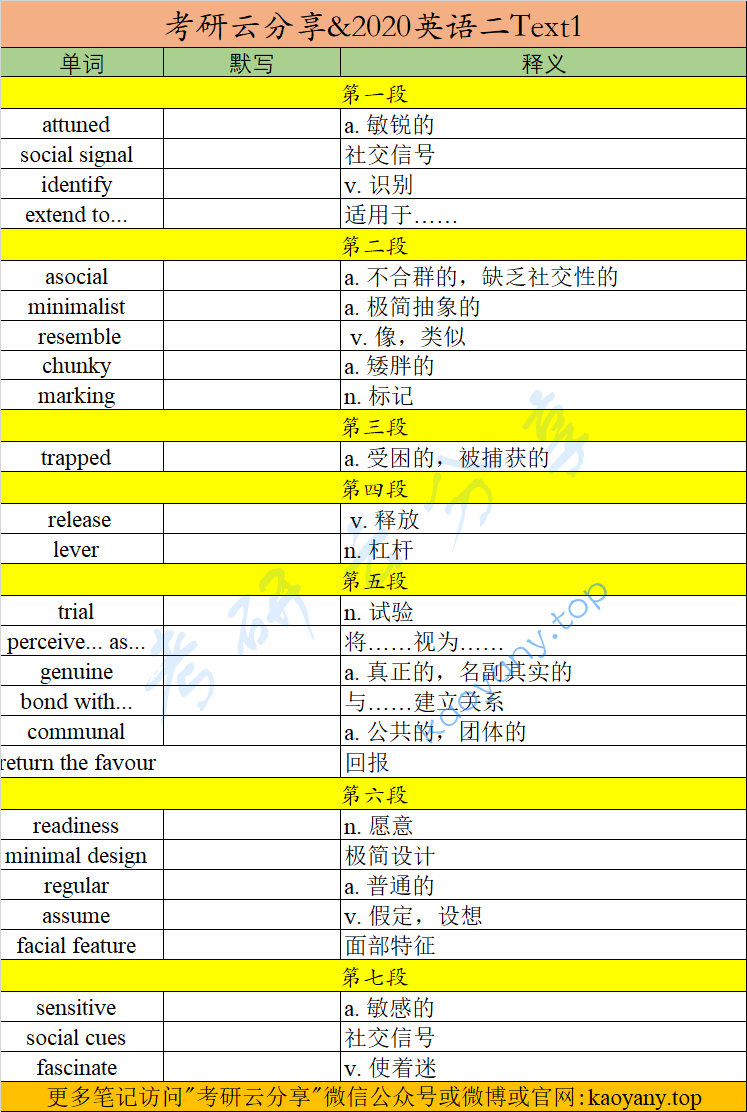第一段
Rats and other animals need to be highly attuned to social signals from others so that can identify friends to cooperate with and enemies to avoid. To find out if this extends to non-living beings, Loleh Quinn at the University of California, San Diego, and her colleagues tested whether rats can detect social signals form robotic rats.
单词&词组
attuned a. 敏锐的
social signal 社交信号
identify v. 识别
extend to... 适用于……
本段翻译
老鼠和其他动物需要高度适应来自他人的社会信号,这样才能识别出要合作的朋友和要避开的敌人。为了找出这种现象是否会扩展到非生物,加州大学圣地亚哥分校的lolehquinn和她的同事们测试了老鼠是否能从机器人老鼠身上检测到社交信号。
第二段
They housed eight adult rats with two types of robotic rat- one social and one asocial一for 5 our days. The robots rats were quite minimalist, resembling a chunkier version of a computer mouse with wheels-to move around and colorful markings.
单词&词组
asocial a. 不合群的,缺乏社交性的
minimalist a. 极简抽象的
resemble v. 像,类似
chunky a. 矮胖的
marking n. 标记
本段翻译
他们把8只成年老鼠和两种类型的机器老鼠关在一起,一种是社交型的,一种是非社交型的。老鼠机器人非常简约,就像一个粗壮的电脑鼠标,有轮子可以移动,还有彩色的标记。
第三段
During the experiment, the social robot rat followed the living rats around, played with the same toys, and opened caged doors to let trapped rats escape. Meanwhile, the asocial robot simply moved forwards and backwards and side to side
单词&词组
trapped a. 受困的,被捕获的
本段翻译
在实验中,社交机器人老鼠跟着活着的老鼠四处游荡,玩同样的玩具,打开笼子的门让被困的老鼠逃脱。同时,这个社交机器人只是简单地前后移动
第四段
Next, the researchers trapped the robots in cages and gave the rats the opportunity to release them by pressing a lever.
单词&词组
release v. 释放
lever n. 杠杆
本段翻译
接下来,研究人员将机器人困在笼子里,让老鼠有机会按下杠杆释放它们。
第五段
Across 18 trials each, the living rats were 52 percent more likely on average to set the social robot free than the asocial one. This suggests that the rats perceived the social robot as a genuine social being. They may have bonded more with the social robot because it displayed behaviours like communal exploring and playing. This could lead to the rats better remembering having freed it earlier, and wanting the robot to return the favour when they get trapped, says Quinn.
单词&词组
trial n. 试验
perceive... as... 将……视为……
genuine a. 真正的,名副其实的
bond with... 与……建立关系
communal a. 公共的,团体的
return the favour 回报
本段翻译
在每18个实验中,活体老鼠释放社交机器人的可能性平均比非社交老鼠高52%。这表明老鼠认为社交机器人是一个真正的社会存在。他们可能更喜欢社交机器人,因为它表现出了共同探索和玩耍的行为。奎恩说,这可能会让老鼠更好地记得早些时候把它放出来的情景,并希望机器人在它们被困住时能报答它。
第六段
The readiness of the rats to befriend the social robot was surprising given its minimal design. The robot was the same size as a regular rat but resembled a simple plastic box on wheels.“We' d assumed we' d have to give it a moving head and tail, facial features, and put a scene on it to make it smell like a real rat, but that wasn’t necessary, ”says Janet Wiles at the University of Queensland in Australia, who helped with the research.
单词&词组
readiness n. 愿意
minimal design 极简设计
regular a. 普通的
assume v. 假定,设想
facial feature 面部特征
本段翻译
考虑到这款社交机器人的最小设计,老鼠们愿意与之成为朋友的意愿令人惊讶。参与这项研究的澳大利亚昆士兰大学的珍妮特·威尔斯(Janet Wiles)说:“我们本以为我们必须给它一个移动的头和尾巴、面部特征,并在它身上设置一个场景,让它闻起来像一只真正的老鼠,但这不是必须的。”。
第七段
The finding shows how sensitive rats are to social cues, even when they come from basic robots. Similarly, children tend to treat robots as if they are fellow beings, even when they display only simple social signals.“ We humans seem to be fascinated by robots, and it turns out other animals are too,”says Wiles.
单词&词组
sensitive a. 敏感的
social cues 社交信号
fascinate v. 使着迷
本段翻译
这项发现显示了老鼠对社会线索的敏感程度,即使它们来自基本的机器人。同样地,孩子们对待机器人的态度往往就好像他们是同类,即使他们只显示简单的社会信号。“我们人类似乎对机器人着迷,而事实证明其他动物也是如此,”威尔斯说。
五道题
21. Quinn and her colleagues conducteda test to see if rats can ——.
[A] pickup social signals fromnon-living rats
[B] distinguish a friendly rat from ahostile one
[C] attain sociable traits throughspecial training
[D] send out warming messages to theirfellow
22. What did the social robot doduring the experiment?
[A] It followed the social robot.
[B] It played with some toys.
[C] It set the trapped Tats free.
[D]It moved around alone.
23. According to Quinn, the ratsreleased the social robot because they ——.
[A] tried to practice a means ofescape
[B] expected it to do the same inreturn
[C] wanted to display theirintelligence
[D]considered that an interesting game
24. James Wiles notes that rats ——.
[A]can remember other rat’s facialfeatures
[B] differentiate smells better thansizes
[C] respond more to cations than tolooks
[D]can be scared by a plastic box onwheels
25. It can be learned from the text thatrats ——.
[A]appear to be adaptable to newsurroundings
(B] are more socially active thanother animals
[C] behave differently from childrenin socializing
[D]are more sensitive to social cuesthan expected
参考答案
A D B C D
答案解析
21. 【答案】A pick up social signals from non-living rats解析:本题目为细节题,考察具体细节。根据题干关键词Quinn and her colleagues和a test定位到第一段第二句。To find out if this extends to non-living beings, Loleh Quinn at the University of California, San Diego, and her colleagues tested whether rats can detect social signals from robotic rats. 为了查明这是否延伸到了非生物,Quinn和她的同事测试了老鼠能否从机器老鼠身上探测到社会信号。正确答案A是原文的同义替换。选项B的distinguish a friendly rat from a hostile one区分友好的老鼠和敌对的老鼠,并未提及,是常识性干扰。选项C的attain sociable traits through special training通过特殊训练获得社交品质,原文并未提及,属于无中生有。选项D的send out warning messages to their fellow向它们的同伴发出警告信息,原文并未提及,属于无中生有。
22.【答案】D It moved around alone.解析:本题目为细节题,考察具体细节。根据题干关键词the asocial robot和experiment定位到第三段最后一句Meanwhile, the asocial robot simply moved forwards and backwards and side to side.同时,不具有社交能力的机器人只能进行简单的前后左右移动。正确答案D It moved around alone.是原文的同义替换。选项A的It followed the social robot.它跟随具备社交能力的老鼠,与原文the social robot rat followed the living rats around不符,原文说的是具备社交能力的老鼠跟随真老鼠,属于张冠李戴。选项B的It played with some toys.它玩一些玩具,与原文不符,原文中说的是具备社交能力的老鼠玩同样的玩具,属于张冠李戴。选项C的It set the trapped rats free.它释放了被困的老鼠也与原文内容不符,原文说的同样是具备社交能力的老鼠,而题干问的是不具备社交能力的老鼠在实验中做了什么,属于张冠李戴。
23.【答案】B expected it to do the same in return解析:本题目为细节题,考察具体细节。根据题干关键词Quinn和the rats released the social robots往下定位到第四五段,第五段最后一句This could lead to the rats better remembering having freed it earlier, and wanting the robot to return the favour when they get trapped, says Quinn. Quinn说:这可能会让老鼠更好地记住早些时候已经释放了机器人,并希望机器人在它们被困住时能回报它们的恩惠。正确答案B expected it to do the same in return是原文的同义替换。干扰项A的 tried to practice a means of escape试图尝试一种逃跑的方法,原文并未提及,属于无中生有。选项C的 wanted to display their intelligence想要展示它们的智慧,文中并未提到,属于无中生有。选项D的considered that an interesting game觉得是个有趣的游戏在原文当中也没有体现,属于无中生有。
24.【答案】C respond more to actions than to looks解析:本题目为细节题,考察具体细节。根据题干关键词James Wiles定位到第六七段,尾段尾句We humans seem to be fascinated by robots, and it turns out other animals are too, says Wiles. Wiles说:“我们人类似乎对机器人很着迷,事实证明其他动物也很着迷。”再结合尾段前面部分的阐述,会发现正确答案C respond more to actions than to looks对行动的反应多于对外表的反应,是原文的类似表达。干扰项A的can remember other rat's facial features能够记住其他老鼠的面部特征,与原文内容不符,原文第六段说的是假设赋予机器老鼠面部特征,那都不重要,属于偷换概念。选项B的differentiate smells better than sizes与体型大小相比,能够更好地区分气味,原文中只提到赋予机器老鼠真老鼠的气味,与原文不符,属于偷换概念。选项D的can be scared by a plastic box on wheels会被装有轮子的塑料盒子吓坏,文中机器老鼠只是装有轮子的塑料盒子,还是属于偷换概念。
25.【答案】D are more sensitive to social cues than expected解析:本题目为推断题,考察基于全文主旨进行推断。题干并没有具体关键词,因此需要通过选项回到文中逐一对应。正确答案D are more sensitive to social cues than expected对社交线索比预期更敏感,与原文尾段首句The finding shows how sensitive rats are to social cues, even when they come from basic robots.(这一发现显示了老鼠对社交暗示的敏感程度,即使是来自基本机器老鼠的社交暗示)属于类似表达。选项A的appear to be adaptable to new surroundings似乎能适应新环境,在文中并未提及,属于无中生有。选项B的are more socially active than other animals比其他动物更活跃,文中只提到其他动物也一样会对机器人着迷,属于偷换概念。干扰项C的behave differently from children in socializing在社交活动中表现得与孩子不同,与原文内容相反,原文内容指的是孩子们倾向于把机器人当作人来对待,即使他们只显示简单的社会信号。这一点与老鼠是一样的,属于正反混淆。

- 单词 词组
- 本段翻译
- 单词 词组
- 本段翻译
- 单词 词组
- 本段翻译
- 单词 词组
- 本段翻译
- 单词 词组
- 本段翻译
- 单词 词组
- 本段翻译
- 单词 词组
- 本段翻译
- 参考答案
- 答案解析
